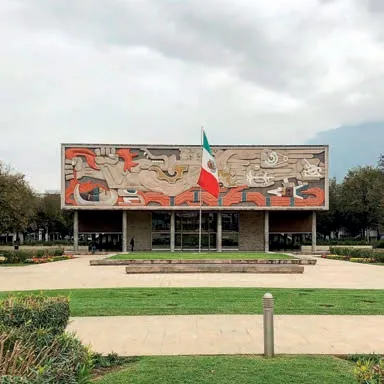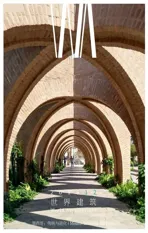墨西哥:传统与进化
2019-12-24戴维巴苏尔托DavidBasulto
戴维·巴苏尔托/David Basulto
庞凌波 译/Translated by PANG Lingbo
作者简介:ArchDaily创始人、主编/Founder & Editor-in-Chief,ArchDaily
作为当今世界上第十五大经济体,墨西哥幅员辽阔,自前哥伦布时代起,在几个世纪的发展中积累出多层次的传统,已然形成一种全球公认的独特身份。墨西哥所具有的身份体现在世界一流的美食、摄影和艺术方面,也体现在新一代建筑师的作品上,他们代表着建筑朝着共同利益与社会发展进化的下一阶段。他们的建筑需要放在一个更大的历史背景下来理解。
从早期开始,经历了玛雅和阿兹特克时期,凭借多样的类型与材料,墨西哥人开始在自然领域中确立自己的聚居地。首先是对地理条件的适应,不论是扩展平原土地,还是走进山地。通过使用类似石材与稻草等本土材料,以及通过在软泥地甚至是湖面上夯实地基、建设先进的水动力基础设施,在前哥伦比亚时期便形成了卓越的城市结构,它们有着大量的公共广场和宏伟庙宇,直到今天仍为人们所研究。
在被西班牙人占领以后,欧洲的影响汇入这里,并缓慢地融合、适应这里的文化与地理环境,逐渐演变成墨西哥建筑的特征。20 世纪早期,建筑在墨西哥现代发展中具有重要作用的时候,她开始积极地接纳发达的国家,以加强工业和基础设施的建设。在此背景下,随着社会的发展,现代主义的理想在此生根,以一种特定的方式发展并契合墨西哥的文化。一批著名的建筑师如费雷克斯·堪迪拉、胡安·奥戈尔曼、马里奥·帕尼、里卡多·莱戈雷塔、胡安·索尔多·马达勒诺、佩德罗·拉米雷斯-巴斯克斯、路易斯·巴拉甘,共同促进形成了这种有着强烈墨西哥身份特征的地域主义。正是从这里开始,物质、光、色彩成为了墨西哥建筑的坚实基础。
这一时期具有代表性的案例之一即佩德罗·拉米雷斯-巴斯克斯的国家人类学博物馆(1964),由阿道夫·洛佩兹·马特奥斯总统委托建造。这是一个“墨西哥人在参观完出来时会为作为一个墨西哥人而感到自豪的”地方[1]。它的方案激进,脱离了欧洲理念中的博物馆是画廊的总和这种概念,在设计中,拉米雷斯-巴斯克斯围绕着一个中心天井布置平面,呼应着前哥伦比亚时期城市的中心广场形态,纪念性的混凝土伞状结构和其大尺度、大体量,令人联想起古代庙宇的规模。这座里程碑式的建筑在当时是世界上最大的博物馆之一,它汇聚了墨西哥数千年的丰富多样的文化,是一座体现了国家精神的现代建筑。
另一个展现墨西哥独特身份的例子是路易斯·巴拉甘的作品,他也是唯一一位荣获普利兹克建筑奖(1980)的墨西哥建筑师。他的创作始于现代主义运动前夕,巴拉甘曾在欧洲旅行的途中,与年轻的勒·柯布西耶相遇[2]。他的作品,如清晰的线条与简洁的体量,在形式上受到了现代建筑师的影响,但在建筑应该是感性的这一点上,这是巴拉甘的远见,与勒·柯布西耶“房子是居住的机器”的概念相对,这使他开启了对建筑的光与色彩的探索。二者的结合远远超越了单纯的构成概念,在强烈的气氛中,物质获得了新的维度,就像在他的自宅(1947)或是吉拉迪住宅(1977)里那样,这些项目如今已成为了建筑朝圣的目的地。
现在,有着1.26 亿人口的墨西哥已成为世界上人口总数排名第十的国家[3],并正在处于城市快速增长的时期。在目前384 个城市的基础上,预期在2030 年将会变为961 个,城市人口也预计将占人口比重的83.2%[4]。在未来的10 年中,预计将有17 座城市人口超越百万,建筑师与城市规划师将面临巨大挑战。
不过,我们仍需重申视角这一问题。墨西哥城如今是世界上第九大城市聚居地,有着超过2280万居住人口,事实上,它几十年来一直是世界上最大的城市之一。自1324 年建立以来,历史的层层积淀以一种独特的方式塑造了这座城市,使它成为世界上最繁华的首都之一。在这里,建筑与交通、急速扩张、城市不平等种种城市的紧迫问题相抗争。
在此背景下,新一代的墨西哥建筑师们在经历了剧烈的进化后,展现出一种独特的身份,他们利用过去的元素来解决墨西哥城市的紧迫问题。从超大规模的民用或商业项目,到将传统住宅重新诠释为旅店,再到在当代建筑中使用传统技艺,在本期专辑中,我们将回顾由传统与进化带来的墨西哥建筑当今的状况。□

1 死亡大道,墨西哥/Avenue of the Dead, Mexico(摄影/Photo: ©Ken Kistler)

2 国家人类学博物馆,佩德罗·拉米雷斯-巴斯克斯/National Museum of Anthropology by Pedro Ramírez-Vásquez(摄影/Photo: ©Dan Gamboa Bohórquez)

3 吉拉迪住宅,路易斯·巴拉甘/Casa Gilardi by Luis Barragán

4 蒙特雷科技大学校区/Monterrey Tec Campus(3.4摄影/Photo: ©David Basulto)
Mexico, today the 15th-largest economy in the world, is a country of vast scales, where layers of accumulated traditions over centuries of development since pre-Columbian times, have shaped a unique identity that is globally recognised. An identity that is present on a world class gastronomy, cinematography,and art, and on the works of a new generation of architects that represent the next step in the evolution of an architecture with a strong orientation towards the common good and the development of its society.An architecture that needs to be understood in a larger historical context.
Since early times, and through Maya and Aztec periods, diverse typologies and materials started to conquer the natural territory that defined Mexican settlements, first, by adapting to the geography, either through extension on flat lands, or by stepping on sloping regions. Using local materials such as stone and straw, and engineering wide foundations and advanced hydraulic infrastructure to build on top of soft soil and even lakes, the pre-Columbian cities achieved advanced urban configurations, with extensive public plazas and magnificent temples that remain object of study until today.
Since the Spanish Conquest, an influx of European influences started to enter the territory and to slowly blend and adapt to the cultural and geographical context, evolving into the Mexican architectural identity. But it was during early 19th century when architecture started to play an important role in the shaping of the Mexican modern state, when the country started to embrace a developed aim towards the strengthening of industry and infrastructure.In this context, as society advanced, the ideals of Modernism found a place to develop and adapt in a particular way, a regionalism with a strong Mexican identity developed by renowned architects such as Felix Candela, Juan O'Gorman, Mario Pani, Ricardo Legorreta, Juan Sordo Madaleno, Pedro Ramírez-Vásquez, Luis Barragán. It is here where matter, light and colour started to become strong pillars of Mexican architecture.
A relevant example of this moment is the National Museum of Anthropology by Pedro Ramírez-Vásquez(1964), commissioned by President Adolfo López Mateos as a place where "[...] Mexicans after visiting it,come out feeling proud of being Mexican"[1]. A radical scheme, away from European ideals of museums configured by the sum of galleries, where Ramírez-Vásquez ordered the programme around a central patio, a gesture to the central square of pre-Columbian cities, with a monumental concrete umbrella and large scale volumes that remind of the scale of ancient temples. A building that marked a before an after by putting together in one of the largest museums of the world at the time, Mexico's vast and diverse culture of thousand of years, on a modern building that embodied the values of the country.
Another example of the unique identity of Mexico is the legacy of Luis Barragán, the only Mexican architect recognised with the Pritzker Architecture Prize (1980). Formed during the dawn of the Modern movement, he traveled Europe extensively and had the chance of meeting a young Le Corbusier[2]. His work was formally influenced by the architects of the time, with clean lines and pure volumes, but it was his vision that architectural should be emotional, contrary to Le Corbusier's concept of "a house is a machine for living in", that led him into an exploration of light and colour on architecture. The result mix between the two went beyond mere composition, resulting in strong atmospheres where matter gained new dimensions as seen on his own House and Studio (1947) or Casa Gilardi (1977), projects that have become destination of architectural pilgrimage.
Today, with 126 million people, Mexico is the 10th most populated country in the world[3], and is going through a fast process of urban growth. It is expected to grow from 384 cities today, to 961 by 2030, when the urban population will account for 83.2% of the total[4]. With 17 cities over one million inhabitants expected in the next 10 years, architects and urbanists will face a big challenge.
But again, perspective. While Mexico City is today the 9th largest urban agglomeration in the world with more than 22.8 million inhabitants, it has been on the list of the world's largest cities for decades. Since its foundation in 1324, the layers of accumulated history have shaped it in a unique way, known as the most intense capitals of the world, and where architecture battles in parallel with the urgencies that transport,rapid sprawl, and urban inequity bring to the city.
In this context, the new generation of Mexican architects show a unique identity after this intense evolution, taking elements of the past to deal with the strong urgencies of Mexican cities. From the monumental scale of civic or commercial projects,to the reinterpretation of traditional houses into hotels or the use of ancestral building techniques on contemporary structures, we review on this issue the current state of Mexican Architecture as a result of Tradition & Evolution.□
参考文献/References
[1] Karina Duque. Clásicos de Arquitectura: Museo de Antropología / Pedro Ramirez Vázquez + Rafael Mijares + Jorge Campuzano [N/OL]. ArchDaily México,2014-09-24 [2019-11-20]. https://www.archdaily.mx/mx/627588/clasicos-de-arquitectura-museo-deantropologia-pedro-ramirez-vasquez-rafael-mijaresjorge-campuzano (ISSN 0719-8914)
[2] The Pritzker Architecture Prize. Biography:Luis Barragán[EB/OL]. [2019-11-20] https://www.pritzkerprize.com/biography-luis-barragan
[3] United Nations Population Division. World Population Prospects (2019)[EB/OL]. [2019-11-20]https://population.un.org/wpp/Download/Standard/Population/
[4] ONU-Habitat. Tendencias del desarrollo urbano en México[EB/OL]. (2017-06-20) [2019-11-20]https://onuhabitat.org.mx/index.php/tendencias-deldesarrollo-urbano-en-mexico
